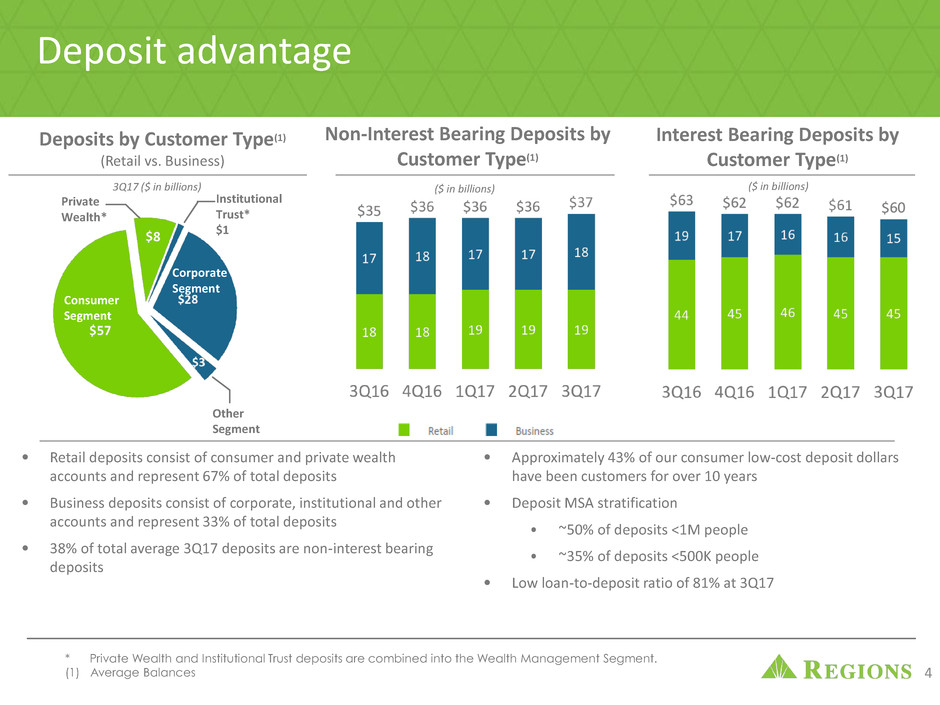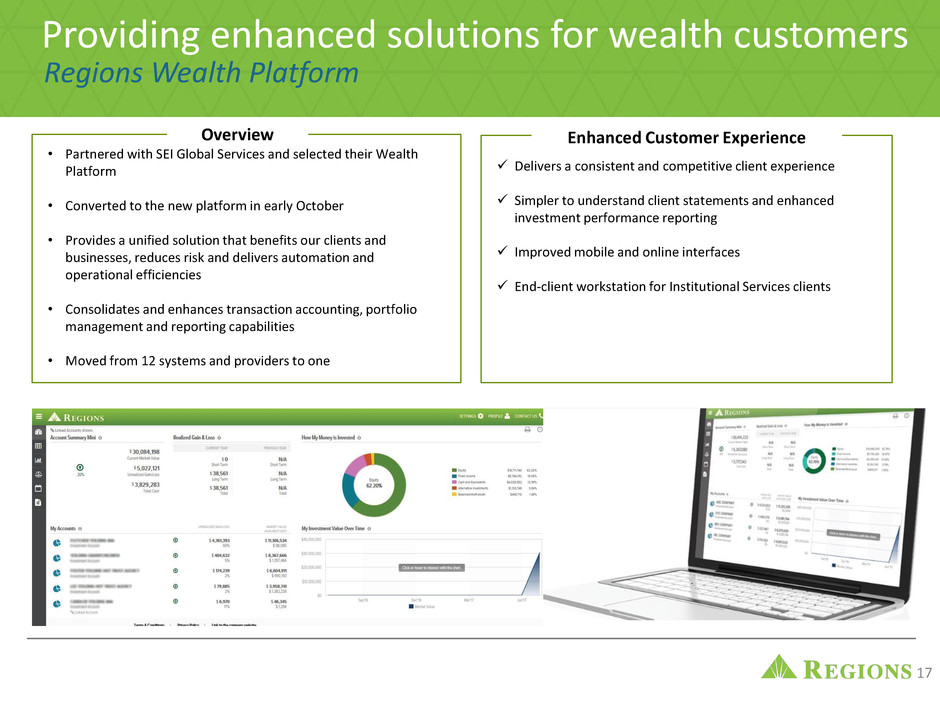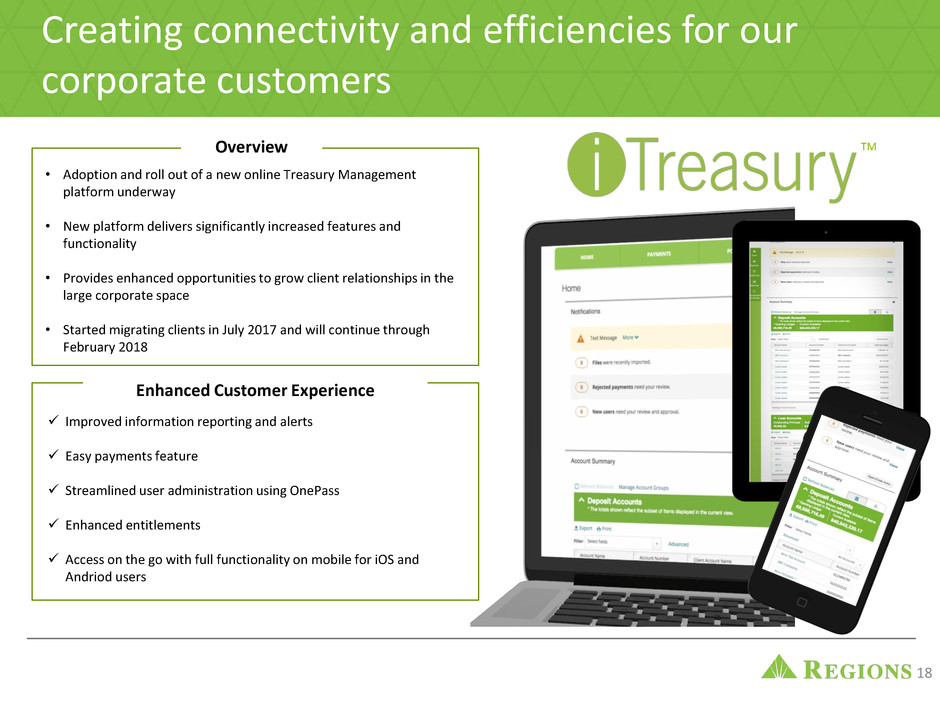Attached files
| file | filename |
|---|---|
| 8-K - 8-K - REGIONS FINANCIAL CORP | rf2017-1114ir.htm |

Bank of America Merrill Lynch
Conference
“Future of Financials”
November 15, 2017
Scott Peters
Consumer Services Group Head
Logan Pichel
Consumer Lending Group Head
Exhibit 99.1

Strategic initiatives
2
GROW AND DIVERSIFY REVENUE
▪ Leverage to grow customers and households and deepen
existing relationships
▪ Prudently grow non-interest income
▪ Balance growth across geographies and businesses
DISCIPLINED EXPENSE MANAGEMENT
▪ Majority of $400MM in expense saves by 2018
▪ Continuously focus on efficiency and effectiveness
▪ Generate positive operating leverage
OPTIMIZE AND EFFECTIVELY DEPLOY REGULATRORY CAPITAL
▪ Attractive ROA and Risk Adjusted Returns
▪ Return appropriate capital to shareholders
®

Consumer
56%
Corporate
33%
Wealth
11%
3
Consumer Bank leading the way
Demonstrated track record of growth
Consumer Growth Metrics
• Strong deposit balance growth while
maintaining pricing discipline
• Solid account growth
• Consumer exports ~$100MM in revenue to
other businesses
• Positive Operating Leverage each
year ‘15-17
• Efficiency ratio improved
~330bps ‘15–17
1 September YTD results as reported in 3Q17 Form 10-Q
2 Excludes Other revenue
$2,316
$2,362
$2,429
2015 2016 2017
Consumer Total Revenue (1)
September YTD ($ millions)
$563
$603
$668
2015 2016 2017
Consumer Pre-Tax Income (1)
September YTD ($ millions)
Total Revenue(1,2)
®

Interest Bearing Deposits by
Customer Type(1)
($ in billions)
Non-Interest Bearing Deposits by
Customer Type(1)
($ in billions)
Other
Segment
Deposit advantage
Deposits by Customer Type(1)
(Retail vs. Business)
• Retail deposits consist of consumer and private wealth
accounts and represent 67% of total deposits
• Business deposits consist of corporate, institutional and other
accounts and represent 33% of total deposits
• 38% of total average 3Q17 deposits are non-interest bearing
deposits
• Approximately 43% of our consumer low-cost deposit dollars
have been customers for over 10 years
• Deposit MSA stratification
⦁ ~50% of deposits <1M people
⦁ ~35% of deposits <500K people
• Low loan-to-deposit ratio of 81% at 3Q17
Consumer
Segment
Private
Wealth*
Corporate
Segment
Institutional
Trust*
$1
* Private Wealth and Institutional Trust deposits are combined into the Wealth Management Segment.
(1) Average Balances
3Q17 ($ in billions)
4

5
Helping customers make better financial decisions
Consumers + Small Businesses
Creating a seamless experience
DIGITAL
ENHANCEMENTS
REMOVE FRICTION &
CREATE EFFICIENCIES
Optimizing
Network and
Loan Portfolios
RESHAPE &
EXPAND
DISTRIBUTION
Leveraging Innovation

✓ New responsive platform
✓ Optimized application and reduced abandonment
✓ Behaviorally targeted ads and advice
✓ Personalized product recommendations
✓ Driving adoption of underutilized sticky services
✓ Optimizing Digital Account Opening
✓ Single Sign On for Consumer/Small Business accounts
Virtual Assistant (rolling out in 2018)
Enhanced 2-way alerts through partnership with FICO (rolling out in 2018)
Key Outcomes:
• 30% increase in digital checking account openings YTD
• 99% increase in mobile deposits and 30% increase in mobile deposit fee income
• Agile environment promotes 4x increased speed to market for new releases
6
6
Digital Enhancements
Providing everything you need at your finger tips
A seamless experience delivered in an Agile environment
Regions Digital Assistant

7
✓ Actively deploy advice, guidance and education content to
customers and prospects through digital and banker channels
✓ Developed and deployed “Build Best Banker (B3)” training
program for retail associates
✓ Launched guided needs assessment tool in branch and digital
Key Outcomes:
• Since 2015, over 700 pieces of advice, guidance and education
content produced with >5 million page views
• Customers engaging with content are 2.25x more likely to
complete online application
• ~4,000 bankers certified through B3 training
Advice, Guidance, and Education
Meeting needs faster and smarter
At every point of customer interaction
7
✓ Targeted and timely customer offers and messages across
channels
✓ Enables targeting of messages throughout entire customer and
prospect lifecycle
✓ Aggregated data and automated decisioning drives an “always
on” environment
✓ Analytics determine the optimal offer and refine ongoing
activities
✓ Continuously learning which improves messaging effectiveness
Key Outcomes:
• Delivering >8 million targeted intercept messages monthly
• Generating over 25% return on investment
Addressable Marketing System

8
8
LockIt
✓ Enhanced card security for both credit and debit
✓ Seamlessly turn transaction types on or off through mobile
device
✓ Pilot rolled out Nov. 1 with full rollout in 2018
✓ Launched in 2017
✓ Leverages customer deposits
✓ Provides credit solutions for everyone
✓ Accounting for ~20% of total new cards monthly
Secured Credit Card
✓ Top performing debit card portfolio for 14 consecutive
quarters(1)
✓ Participate in Apple Pay, Samsung Pay, Android Pay and Visa
Checkout
Debit Card
(1) Visa Quarterly Power Score Survey
Comprehensive and expanding payment solutions
Early participant in all payment networks
TM

✓ Providing unique payment solutions to meet customer needs
✓ Differentiated remote deposit options that allow for expedited
availability of funds
✓ Check cashing solutions across channels
✓ Western Union bill payment and money transfer
✓ General Purpose Reloadable card solution
Key Outcomes:
• Meeting needs for ~575,000 Now Banking households
• 41% CAGR in mobile check cashing revenue last 3 years of
program
Enhanced person-to-person payments
will be rolled out early 2018
9
NOW BANKING ®
Comprehensive and expanding payment solutions
Early participant in all payment networks (continued)

10
Retail Network Strategy
• Critical component of our go to market strategy
• Consolidate non-strategic and lower performing locations
• Adding distribution in dense fast growing markets in our footprint
• Goal: 10% decrease in branches and 10% increase in bankable population
Target Growth Markets
Closed Branches (16-17)
10
The right branches in the right places
Retail network strategy
✓ By the end of 2017 - 163 consolidations & ~10% reduction in
branches since Investor Day 2015
✓ 21% reduction in branches since YE 2009
1895
1627
1489
2009 YE 2015 YE 2017 YTD
Branch Count

75% Routine Transactions
25% Customer Value Add
75% Customer Value Add
25% Routine Transactions
Historic
State:
Target
State:
▪ Customer completes routine transactions digitally
▪ Customers rely on branch bankers to help make better financial
decisions
▪ All associates will be revenue generating
▪ Reduced ~1,300 Tellers (23%) since Jan 2016 with more to come
▪ Trained Bankers now exceed Tellers in FTE count
▪ Customer completes routine transactions in the branch
▪ Customers rely on branch bankers to help make better financial
decisions
▪ Staffing two job families to peak times creates latency
11
Making Banking Easier strives to move routine transactions out of the branch to other channels and
increase the focus on high value interactions
11
Improving the customer experience in the branch
Making Banking Easier

✓ Launched responsive design for Regions.com allowing customers
seamless access from any device
✓ Leveraging artificial intelligence to meet customer needs in contact
center, while reducing headcount
✓ Provided small business customers single sign on capability to access
personal and business accounts
✓ Fully deployed deposit smart ATM fleet
✓ Remote deposit platform with multiple availability options migrating
routine transactions to lower cost channel
✓ E-signature capabilities provide for significant improvement
opportunities in back-end processes
Launch Paid Solutions for Small Businesses in online banking
Key Outcomes:
• Regions ranked 2nd out of 257 companies across 20 industries in the
2016 Temkin Web Experience Ratings
• Consumer Bank efficiency ratio improvement of ~330 bps over last 3
years
12
12
Continuous Improvement
Reducing friction while creating efficiencies
Journey of continuous improvement

✓ In 2010 high concentration of real-estate
✓ Needed to create better diversification in the portfolio
✓ Expanded indirect auto lending with dealerships
✓ Developed a point-of-sale relationship
✓ Purchased our credit card portfolio and continued to
expand
✓ Piloted a fully digital loan experience
13
Diversifying the consumer loan portfolio
Loan Diversification Strategy and
Accomplishments

Innovation driving consumer loan growth
✓ Originated $3.0B in production and $1.2B in balances since program
inception in December 2014
✓ Completed first bulk purchase of $138MM in June 2017
✓ Recently expanded our commitment from $1.0B to $2.0B
✓ Exceeding volume expectations and meeting credit expectations
Next Step: Looking to add additional partnerships
GreenSky® / Indirect Lending Other
Fully digital loan originations / Direct Lending
✓ Growing rapidly, represents almost 10% of direct loan production
✓ 500% increase in digital lending in last year
✓ Maintained high credit quality standards
Next Step: Expand to other products beyond unsecured lines of credit
to all consumer loan products
Non-Real Estate Consumer Loan
Balances
($ in millions)
1.8
2.2
0.2
1.3
0.9
1.1
1.0
1.2
$3.9
$5.8
12/31/2014 9/30/2017
14

Leveraging innovation with lending capabilities
15
Fully Digital Loan Experience
Regions.com ………. Online Banking
• Changing customer expectations
• Create a better customer experience
• Increase productivity of bankers
• Leverage partnerships with Avant® and
FundationTM
• Expand online lending capabilities
• Pre-approved loans
• No application process
• Click to accept terms and receive
funds
Online Application for Small Business Loans and Lines of Credit
Funds for working capital to manage
cash flow or for inventory
Funds for business expansion or
capital improvements
Funds to purchase equipment Funds to purchase real estate or
to refinance a loan on real estate
• Average time to complete
application: 5 minutes
• Average decision time: 3 seconds
• % of loans funded same day: 35%
• Regions + Avant®: August 2016
• Regions + FundationTM: August 2015
• Regions Online Banking: July 2017
Our Quickest Loan Application. Designed Just for You.

Creating a fully digital loan experience for all consumer loans
Universal Application
• Online applications
• Device-driven responsiveness
• Phones, tablets, PCs, etc.
Information Collection
• Document upload
• Automated data retrieval
Digital Closing
• eSignature
• eDelivery
Processing
• Automated decision making
• Status alerts
• Document imaging
• Workflow automation
Digital Servicing
• Automated boarding
• Electronic statements
• Online payments
• Maintenance
16
New online application for
mortgage and home equity
loans/lines (Dec. 2017)
• 48% fewer questions
• Device-driven responsiveness
• Intuitive questions
• Prefills customer information
• Reduces application time to
< 5 minutes
Our goal… make it easier for consumers to borrow
and develop a more productive banker

Overview Enhanced Customer Experience
✓ Delivers a consistent and competitive client experience
✓ Simpler to understand client statements and enhanced
investment performance reporting
✓ Improved mobile and online interfaces
✓ End-client workstation for Institutional Services clients
• Partnered with SEI Global Services and selected their Wealth
Platform
• Converted to the new platform in early October
• Provides a unified solution that benefits our clients and
businesses, reduces risk and delivers automation and
operational efficiencies
• Consolidates and enhances transaction accounting, portfolio
management and reporting capabilities
• Moved from 12 systems and providers to one
17
Providing enhanced solutions for wealth customers
Regions Wealth Platform

Overview
• Adoption and roll out of a new online Treasury Management
platform underway
• New platform delivers significantly increased features and
functionality
• Provides enhanced opportunities to grow client relationships in the
large corporate space
• Started migrating clients in July 2017 and will continue through
February 2018
Enhanced Customer Experience
✓ Improved information reporting and alerts
✓ Easy payments feature
✓ Streamlined user administration using OnePass
✓ Enhanced entitlements
✓ Access on the go with full functionality on mobile for iOS and
Andriod users
18
Creating connectivity and efficiencies for our
corporate customers
TM

Innovation strategy supports our strategic initiatives
Grow and
Diversify
Revenue
Disciplined
Expense
Management
Optimize and
Effectively
Deploy Capital
✓ Making Banking Easier
✓ Addressable Marketing
✓ Website redesign and online
enhancements
✓ Payment innovations
✓ Point-of-sale lending partnerships
✓ iTreasury
Fully Digital Loan Experience
✓ Optimized digital account opening
✓ Agile
✓ Imaging
✓ Regions Wealth Platform
Artificial intelligence
eSignature
eClosings / eContracting
System consolidation
✓ Retail network strategy
✓ Consumer loan diversification
Enhanced 2-way alerts
Automated decision making
Enterprise data strategy
19

®
20

21
Appendix

Forward-looking statements
This presentation may include forward-looking statements as defined in the Private Securities Litigation Reform Act of 1995. The terms “Regions,” the “Company,” “we,” “us” and “our” mean Regions Financial Corporation, a
Delaware corporation, and its subsidiaries when or where appropriate. The words “anticipates,” “intends,” “plans,” “seeks,” “believes,” “estimates,” “expects,” “targets,” “projects,” “outlook,” “forecast,” “will,” “may,” “could,” “should,”
“can,” and similar expressions often signify forward-looking statements. Forward-looking statements are not based on historical information, but rather are related to future operations, strategies, financial results or other
developments. Forward-looking statements are based on management’s current expectations as well as certain assumptions and estimates made by, and information available to, management at the time the statements are made.
Those statements are based on general assumptions and are subject to various risks, and because they also relate to the future they are likewise subject to inherent uncertainties and other factors that may cause actual results to differ
materially from the views, beliefs and projections expressed in such statements. Therefore, we caution you against relying on any of these forward-looking statements. These risks, uncertainties and other factors include, but are not
limited to, those described below:
• Current and future economic and market conditions in the United States generally or in the communities we serve, including the effects of declines in property values, unemployment rates and potential reductions of economic growth, which
may adversely affect our lending and other businesses and our financial results and conditions.
• Possible changes in trade, monetary and fiscal policies of, and other activities undertaken by, governments, agencies, central banks and similar organizations, which could have a material adverse effect on our earnings.
• The effects of a possible downgrade in the U.S. government’s sovereign credit rating or outlook, which could result in risks to us and general economic conditions that we are not able to predict.
• Possible changes in market interest rates or capital markets could adversely affect our revenue and expense, the value of assets and obligations, and the availability and cost of capital and liquidity.
• Any impairment of our goodwill or other intangibles, any repricing of assets, or any adjustment of valuation allowances on our deferred tax assets due to adverse changes in the economic environment, declining operations of the reporting
unit, adverse consequences related to tax reform, or other factors.
• Possible changes in the creditworthiness of customers and the possible impairment of the collectability of loans and leases, including operating leases.
• Changes in the speed of loan prepayments, loan origination and sale volumes, charge-offs, loan loss provisions or actual loan losses where our allowance for loan losses may not be adequate to cover our eventual losses.
• Possible acceleration of prepayments on mortgage-backed securities due to low interest rates, and the related acceleration of premium amortization on those securities.
• Our ability to effectively compete with other financial services companies, some of whom possess greater financial resources than we do and are subject to different regulatory standards than we are.
• Loss of customer checking and savings account deposits as customers pursue other, higher-yield investments, which could increase our funding costs.
• Our inability to develop and gain acceptance from current and prospective customers for new products and services in a timely manner could have a negative impact on our revenue.
• The effects of any developments, changes or actions relating to any litigation or regulatory proceedings brought against us or any of our subsidiaries.
• Changes in laws and regulations affecting our businesses, such as the Dodd-Frank Act and other legislation and regulations relating to bank products and services, as well as changes in the enforcement and interpretation of such laws and
regulations by applicable governmental and self-regulatory agencies, which could require us to change certain business practices, increase compliance risk, reduce our revenue, impose additional costs on us, or otherwise negatively affect our
businesses.
• Our ability to obtain a regulatory non-objection (as part of the CCAR process or otherwise) to take certain capital actions, including paying dividends and any plans to increase common stock dividends, repurchase common stock under current
or future programs, or redeem preferred stock or other regulatory capital instruments, may impact our ability to return capital to stockholders and market perceptions of us.
• Our ability to comply with stress testing and capital planning requirements (as part of the CCAR process or otherwise) may continue to require a significant investment of our managerial resources due to the importance and intensity of such
tests and requirements.
• Our ability to comply with applicable capital and liquidity requirements (including, among other things, the Basel III capital standards and the LCR rule), including our ability to generate capital internally or raise capital on favorable terms, and
if we fail to meet requirements, our financial condition could be negatively impacted.
• The Basel III framework calls for additional risk-based capital surcharges for globally systemically important banks. Although we are not subject to such surcharges, it is possible that in the future we may become subject to similar surcharges.
• The costs, including possibly incurring fines, penalties, or other negative effects (including reputational harm) of any adverse judicial, administrative, or arbitral rulings or proceedings, regulatory enforcement actions, or other legal actions to
which we or any of our subsidiaries are a party, and which may adversely affect our results.
• Our ability to manage fluctuations in the value of assets and liabilities and off-balance sheet exposure so as to maintain sufficient capital and liquidity to support our business.
22

• Our ability to execute on our strategic and operational plans, including our ability to fully realize the financial and non-financial benefits relating to our strategic initiatives.
• The success of our marketing efforts in attracting and retaining customers.
• Possible changes in consumer and business spending and saving habits and the related effect on our ability to increase assets and to attract deposits, which could adversely affect our net income.
• Our ability to recruit and retain talented and experienced personnel to assist in the development, management and operation of our products and services may be affected by changes in laws and regulations in effect from time to time.
• Fraud or misconduct by our customers, employees or business partners.
• Any inaccurate or incomplete information provided to us by our customers or counterparties.
• The risks and uncertainties related to our acquisition and integration of other companies.
• Inability of our framework to manage risks associated with our business such as credit risk and operational risk, including third-party vendors and other service providers, which could, among other things, result in a breach of operating or
security systems as a result of a cyber attack or similar act.
• The inability of our internal disclosure controls and procedures to prevent, detect or mitigate any material errors or fraudulent acts.
• The effects of geopolitical instability, including wars, conflicts and terrorist attacks and the potential impact, directly or indirectly, on our businesses.
• The effects of man-made and natural disasters, including fires, floods, droughts, tornadoes, hurricanes, and environmental damage, which may negatively affect our operations and/or our loan portfolios and increase our cost of conducting
business.
• Changes in commodity market prices and conditions could adversely affect the cash flows of our borrowers operating in industries that are impacted by changes in commodity prices (including businesses indirectly impacted by commodities
prices such as businesses that transport commodities or manufacture equipment used in the production of commodities), which could impair their ability to service any loans outstanding to them and/or reduce demand for loans in those
industries.
• Our inability to keep pace with technological changes could result in losing business to competitors.
• Our ability to identify and address cyber-security risks such as data security breaches, malware, “denial of service” attacks, malware, “hacking” and identity theft, a failure of which could disrupt our business and result in the disclosure of
and/or misuse or misappropriation of confidential or proprietary information; disruption or damage to our systems; increased costs; losses; or adverse effects to our reputation.
• Our ability to realize our adjusted efficiency ratio target as part of our expense management initiatives.
• Significant disruption of, or loss of public confidence in, the Internet and services and devices used to access the Internet could affect the ability of our customers to access their accounts and conduct banking transactions.
• Possible downgrades in our credit ratings or outlook could increase the costs of funding from capital markets.
• The effects of problems encountered by other financial institutions that adversely affect us or the banking industry generally could require us to change certain business practices, reduce our revenue, impose additional costs on us, or
otherwise negatively affect our businesses.
• The effects of the failure of any component of our business infrastructure provided by a third party could disrupt our businesses; result in the disclosure of and/or misuse of confidential information or proprietary information; increase our
costs; negatively affect our reputation; and cause losses.
• Our ability to receive dividends from our subsidiaries could affect our liquidity and ability to pay dividends to stockholders.
• Changes in accounting policies or procedures as may be required by the FASB or other regulatory agencies could materially affect how we report our financial results.
• Other risks identified from time to time in reports that we file with the SEC.
• The effects of any damage to our reputation resulting from developments related to any of the items identified above.
The foregoing list of factors is not exhaustive. For discussion of these and other factors that may cause actual results to differ from expectations, look under the captions “Forward-Looking Statements” and “Risk Factors” of Regions’ Annual Report
on Form 10-K for the year ended December 31, 2016, as filed with the SEC. Regions’ Investor Relations contact is Dana Nolan at (205) 264-7040; Regions’Media contact is Evelyn Mitchell at (205) 264-4551.
Forward-looking statements continued
23
